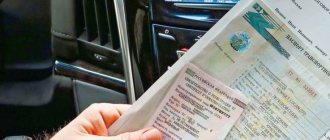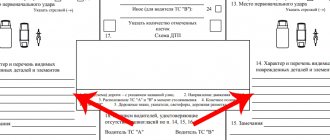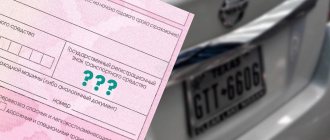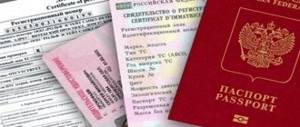What is OSAGO
Art. 4 Federal Law No. 40 of April 25, 2002 establishes the obligation of car owners and drivers to insure their civil liability to third parties (MTPL). This provides victims with compensation for damage to life, health and property caused by using a source of increased danger (Article 1079 of the Civil Code of the Russian Federation). The compensation is paid by the insurer, not the direct cause of harm.
As confirmation, the driver receives a policy - a document that specifies the type of vehicle, calculation of the premium, individual coefficients, territory, validity period and other information. Since 2021 (and formally - since 2015), a compulsory motor liability insurance contract can be concluded via the Internet, without the need to contact a branch of the insurer.
This innovation was dictated by the prevailing circumstances: for many insurers, compulsory motor liability insurance is an unprofitable business, so they previously boycotted the sale of policies under various pretexts, and motorists, in turn, could not comply with the law. In 2021, the insurance company does not have the right to refuse a client if he applies to him with an application to conclude an agreement online (clause 7.2 of article 15 of Federal Law No. 40).
Features of the electronic policy
An electronic policy has the same legal force as one prepared on a special paper form. Since 07/01/2018, a new unified e-OSAGO form with the XXX series has been used. One of its differences from the old one is the presence of a QR code. It contains information about the name of the seller, details and date of issue of the policy, as well as data on the car and driver. This code gives direct access to the RSA (Russian Union of Auto Insurers) database.
The policyholder receives the document by e-mail and in the Personal Account in the form of a PDF file, signed with an enhanced qualified signature of the insurance company. Along with it, a check, a Europrotocol form and a reminder for the client are sent on how to print out the MTPL policy and provide it upon request of the traffic police. The driver has the right to receive insurance on paper in person at the office or to his home address, having paid for postage.
It is important to know! The insurance company enters information about the issued policy into an automated information system administered by RSA. Access to this database is open; any user can verify the authenticity of a document by its series, number or QR code.
The policy period begins no earlier than 3 days after sending the application to the insurance company and paying the insurance premium. The user has the right to choose and indicate the day for concluding the contract.
What if the inspector does not accept insurance in this form?
Despite the fact that the regulations for checking the MTPL policy online have been adopted for a long time, some traffic police officers may insist on their own: no piece of paper - no insurance. What to do in this situation?
- Most insurance companies still recommend printing out the e-MTPL policy and taking it with you. In this case, you will have something to show when checking. Perhaps this fact will already satisfy him, although the printed version cannot be considered a full-fledged document (there is no stamp on it). And, nevertheless, you can drive with a copy of the policy for your own peace of mind.
Some drivers ask whether it is possible to show the MTPL policy on the phone? Yes, you can. In accordance with the latest amendment, from January 2, 2021, a paper version is no longer required.
Do I need to carry a paper copy with me?
Initially, the law strictly required that you carry the original policy with you, which was impossible in the case of e-MTPL. The first explanations from the traffic police gave drivers freedom of choice: they could print a document, show it on the screen of a mobile device, or simply declare that they have insurance. Letter No. 13/12-u-4440 of the Main Traffic Safety Inspectorate of the Ministry of Internal Affairs dated 07/03/2015 shifted all responsibility for checking information to traffic police inspectors.
However, not all traffic police posts are equipped with technical means that allow real-time verification of the conclusion of a contract. Therefore, changes were made to Federal Law No. 40 and clause 2.1 of the Traffic Regulations of the Russian Federation, which precisely determined whether it is necessary to carry a compulsory motor liability insurance policy with you (Federal Law No. 214 of June 23, 2016, Government Decree No. 1414 of November 24, 2018). Additionally, the Bank of Russia, in its clarification dated January 3, 2017, clarified that the document must be printed and a copy presented at the request of traffic police officers.
Judicial practice also testifies to this. For example, in case No. 72-798/2018 dated July 18, 2018, the legality of imposing a penalty of 500 rubles. confirmed by the court of first instance and the Sverdlovsk Regional Court of Appeal. The defendant did not know whether the driver was required to present a printed insurance policy to the traffic police inspector, so he showed the downloaded file on the screen of his smartphone.
Is it necessary to show insurance to a traffic cop in Russia in 2021?
Many novice drivers are interested in: do they need to show paper insurance to a traffic cop in Russia? Starting in 2021, the State Duma approved in the first reading a useful bill prohibiting the presentation of regressive compulsory insurance requirements to pedestrians who are at fault for road accidents in which they were injured.
This bill equalizes the importance of electronic/paper policies: they will be considered a single type of compulsory motor liability insurance. Then, to the question: “Is the driver obliged to present insurance to the traffic police inspector in a paper version?”, the answer will be negative. The only thing that motorists will need to present to traffic cops is the number code of the MTPL policy.
Attention! If such an initiative is approved, then all compulsory insurance (paper/electronic format) will receive a unique number code. Using this code, traffic cops will check for the presence of a document: drivers in Russia will have to show the OSAGO number on the phone screen, or dictate it. The inspector will only have to “check” the insurance through the electronic database.
If the amendments are adopted, the inspector will not be able to require the provision of paper insurance, and insurance companies will be able to significantly save on purchasing from the State Insurance Company. sign" of expensive strict reporting forms equipped with special protection. At the same time, the legal norm that allows you to obtain insurance from an insurance company on company letterhead will remain. This means that an absolute transition to an electronic vehicle license on the territory of the Russian Federation will not happen in the near future.
Related article: Applying for insurance retroactively
The State Duma adopted the document in the first reading, then the initiative will undergo the main second and third readings. If the initiative is approved, it will only come into force six months after its official publication.
Accordingly, if acceptance happens “without rough edges,” real changes will become noticeable. And, the situation today is such that drivers, while on the road, are required to carry with them either an ordinary paper policy or a printed electronic one.
In what cases is a motor vehicle license required?
Since July 10, 2017, compulsory motor liability insurance has been officially excluded from the list of mandatory documents when registering a car (Order of the Ministry of Internal Affairs No. 139 of March 20, 2017). Inspectors check information about insurance when registering a vehicle through an interdepartmental request to the RSA.
In what cases does a driver provide an insurance policy to a traffic police officer:
- when a car is stopped by traffic police patrolmen;
- when registering an accident.
Art. 106 of the Order of the Ministry of Internal Affairs No. 664 dated August 23, 2017 specifies in which cases the insurance policy is transferred to the traffic police inspector:
- if there is reason to believe that the motorist violated traffic rules;
- if there is an orientation towards a similar driver or car;
- when carrying out measures to reduce the number of accidents;
- upon request when stopping for any other reason, for example to check the equipment (first aid kit, emergency sign, fire extinguisher).
Attention! Insurance is included in a mandatory set of documents for a motorist. Before presenting the electronic MTPL to the traffic police, the driver prints out a confirmation letter from the insurance company on A4 paper.
What documentary package should be provided to traffic police officers upon request in 2021?
The text of the code of laws “on compulsory motor liability insurance” clearly states that every motorist is a person obliged to provide his own insurance in three situations:
- in case of an accident;
- in case of non-compliance with traffic rules;
- when deregistering a car.
Clause 2.1.1. The traffic rules answer the question in the affirmative: does a traffic inspector have the right to carry out an inspection? When carrying out the check, the traffic police officer must: introduce himself, indicate his position, indicate the reason for the braking.
Accordingly, the reciprocal responsibility of the vehicle owner is to provide a documentary package consisting of:
- driver's license;
- documents having registration value;
- insurance policy.
This list is mandatory for all drivers, regardless of the situation. Answering the question: “Does a traffic police officer have the right to demand to see the above papers?”, the answer will be positive. In turn, the driver is obliged to present the MTPL to the traffic inspector. At the same time, the insurance must not be expired, and the driver specified in the policy must be in the driver’s seat.
The legislative framework
The law “On Compulsory Motor Liability Insurance” regulates the entire range of issues regarding compulsory insurance.
Following this law (clause 1, article No. 4), all motorists are required to draw up agreements on compulsory motor liability insurance. Otherwise, the vehicle is considered unsuitable for driving on public roads.
Contents of clause 2.1.1., art. No. 2 of the traffic rules informs the following: when driving a car, the driver is obliged to take with him and also provide the traffic inspector with his insurance. But, at the same time, the traffic inspector must have objective reasons for carrying out an inspection of the person behind the wheel.
Contents of paragraph 106 admin. The traffic police regulations say that such requirements include:
- fact of recording a traffic violation;
- the fact that there are guidelines for a specific vehicle;
- the fact of carrying out specialized actions/operations aimed at preventing road accidents;
- the fact that the driver violated the requirements for safe driving (heavily tinted windows, etc.).
The content of clause 84.13 of the Administrative Regulations of the State Traffic Inspectorate informs that the traffic inspector has every right to slow down the car to audit documents for the ability to drive the vehicle, as well as papers for the car.
You should know! If desired, the traffic police officer can easily find many reasons to check the documentary package: at the same time, the driver cannot refuse.
The procedure for checking an electronic policy by traffic police officers
The traffic police patrol checks the authenticity and validity period of the document using the details or QR code in the RSA. For this purpose, there are laptops or tablets at stationary posts and in inspectors’ cars.
On the RSA website, in the “Checking OSAGO policies” section, enter the document series and its number, captcha. The answer comes instantly - it contains information about the insurance company, the car, the date of conclusion of the contract, its validity period, and so on.
With the appearance of a QR code on policy forms, the task is simplified: you can find out whether e-OSAGO is valid using any smartphone that has the RSA mobile application installed and has the Internet (“Road accident. Europrotocol”). The check occurs quickly, without the need to access a laptop or call the unit.
Is it necessary to have an insurance agreement in a car?
Many car enthusiasts are interested in: “Is it the responsibility of the autopilot to monitor the presence of the MTPL policy in their car?” The traffic rules do not regulate the form in which the insurance policy should be stored and provided to traffic police officers. The problem is complicated by the fact that most people apply for compulsory motor liability insurance online, receiving it electronically via computer mail.
Article on the topic: Payments under compulsory motor liability insurance to the culprit of an accident
For a deciphering of the requirements of the traffic rules clause 2.1.1., informing about the storage/provision of mandatory insurance coverage to traffic inspectors, you should contact the RSA website, which states the following: store/display insurance for inspection to traffic police officers, should be in paper form.
Attention! The E-OSAGO policy must be printed. The paper equivalent of electronic insurance must mirror the entire information base of its digital original, and all data must be easy to read.
If the driver is not the owner of the car being used, the owner’s electronic insurance is not considered adequate. The owner of the car must draw up a separate agreement on compulsory motor liability insurance, taking into account the entire period of use of the car, otherwise the traffic inspector may impose penalties: on the owner/on the illegal driver.
The following fines are paid:
- for driving without a policy – 500 rubles;
- for failure to issue a policy – 800 rubles;
- for driving a car during a period not specified in the insurance – 500 rubles;
- for a driver who is not listed in the insurance – 800 rubles.
Fine for lack of document
As everyone understands, ignorance of the laws does not exempt you from responsibility. The driver’s failure to have a printed policy can result in one of two penalties:
- according to Part 2 of Art. 12.37 Code of Administrative Offenses of the Russian Federation - a fine of 800 rubles. for failure to comply with insurance rules (for the absence of compulsory motor liability insurance at all);
- Part 2 Art. 12.3 of the Code of Administrative Offences—a penalty of 500 rubles. or a warning (with the obligatory issuance of a resolution) for a printout forgotten at home.
When asked whether you need to carry a copy of your MTPL policy with you, the answer is unequivocal - yes, you do. If a motorist cannot confirm the registration of insurance with at least a file saved on a smartphone, by default it is considered that he is guilty under Part 2 of Art. 12.37 Code of Administrative Offenses of the Russian Federation. But he has the right to challenge and re-qualify the punishment under Part 2 of Art. 12.3, if he proves that he had a valid policy at the time of the stop.
It is important to know! In 2021, a system is expected to be put into operation that checks the availability of insurance against the PCA database online using traffic cameras, followed by the distribution of chain letters.
However, the implementation of this project requires combining the RSA and traffic police databases: it is necessary to synchronize data from the AIS with the license plates of the cars that are read by the tracking devices. Most likely, the first test devices will be installed in pilot regions in the fall of 2019.
Let's sum it up
Despite the fact that the traffic police have the opportunity to check the authenticity of insurance in two ways (in the Ministry of Internal Affairs database or on the RAS website), some inspectors may not be qualified enough and refuse to do this. But this is not a reason to panic: according to the law, you can drive with an electronic MTPL policy. However, we recommend that you have with you a printed version of the e-MTPL policy, which insurance companies send by mail. In some situations, paper insurance can help reassure an employee of your integrity.
What to do if the printed form is not accepted
The printout does not have degrees of protection, a “live” signature or seal of the insurer. It is impossible to verify the authenticity of e-OSAGO only visually. And the lack of technical means to search for an electronic policy in the RSA is a problem for a traffic police officer. If the inspector does not accept the form and threatens with a fine, the driver has the right to:
- call the single number 102 (from mobile phones). There is a “hotline”, which is provided specifically for reporting violations by employees of the Ministry of Internal Affairs (and the traffic police) - 8 (800) 222-74-47;
- appeal the actions of the inspector in the order of subordination to higher management;
- challenge them in court.
You can independently “punch” your electronic MTPL policy before presenting it to the traffic police.
It is especially advisable to do this for those who took out insurance not on the official website of the insurance company, but from agents or on third-party Internet resources (the database contains information only on “car insurance”; CASCO cannot be checked this way). In 2018-2019, traffic police inspectors calmly react to such insurance and promptly check whether the electronic MTPL policy printed online is valid. Back in 2021, drivers were massively issued fines under Part 2 of Art. 12.37 Code of Administrative Offences. However, controversial situations still occur, so the verification system continues to be improved.
For example, at the beginning of 2021, the State Duma is considering bill No. 501904-7. Among other things, it eliminates duplicates in the AIS RSA among issued paper and electronic policies, and clarifies the list of information that insurers enter into the database when registering e-MTPL. These changes are expected to make the system of compulsory online insurance in the Russian Federation simpler and more unified.
Possible problems when using an electronic OSAGO policy
Until electronic policies were introduced, any driver had to take with him insurance the size of an A4 sheet, certified by the insurance company. After presenting the insurance, the traffic police inspector checks the insurance for its authenticity, checking the information from the VU.
Attention! Today, all Russians driving are required to have a printout of the electronic policy in order to demonstrate it at the direction of the traffic inspector. If there is no policy (or the term has expired), the traffic cop issues a fine.
“At the dawn” of the creation of services, the procedure for obtaining/using electronic policies was associated with a lot of problems. For example, some insurance companies on their websites offered to buy compulsory motor liability insurance, but at the same time, the services worked with large delays. Many insurance companies deliberately created similar obstacles in the implementation of electronic sales of compulsory motor liability insurance due to the fact that when registering online, it is not possible to sell insurance to the owner of the vehicle, with an increased set of additional options. services.
Article on the topic: Features of compulsory motor liability insurance in Tinkoff Insurance Insurance Company
Today there is an active fight against fraud in the field of online insurance. The main problems of using E-OSAGO have already been successfully resolved.
This policy has many advantages:
- there is no registration fee;
- is issued in an accessible and prompt manner;
- easy to print.
It is especially convenient to issue an electronic policy for people living at considerable distances from the offices of the insurance company: you just need to look at the “territory” of the insurer’s website and send the required information. When registering for E-MTPL, the previously accumulated bonus-malus coefficient does not go away.
The only difficulty with electronic insurance is that there is no possibility of making adjustments to the insurance contract. It is impossible to add/remove drivers or change passport details via the Internet: to do this you will have to go to the IC office. But there is hope that this problem will be solved in the near future.
The traffic inspector does not want to accept E-OSAGO: what to do?
Many motorists complain: when a printed electronic OSAGO policy is presented to a traffic police inspector, he turns out to accept it.
Helpful information! Today, such insurance is not recognized as an official document, and its printed copy often causes a “fit” of mistrust among traffic cops. In this situation, the motorist must ask the traffic police officer to contact the services of a specialized service.
Audit of electronic insurance does not require much time. If a traffic cop refuses to contact the service, explaining this by lack of access to it, then this is no longer a problem for the person sitting behind the wheel. It is easy to cancel the imposed penalty in the case where the OSAGO number code is actually entered into the register.
How does a traffic police officer check an electronic policy?
The inspection process for electronic insurance is similar to the inspection process for regular standard insurance. If, during an inspection of electronic insurance, the inspector has complaints, he must contact the IMTS or the RSA database: the VIN will be required, as well as the state registration number. vehicle number. In the same way, you can check using the number code on the printout.










